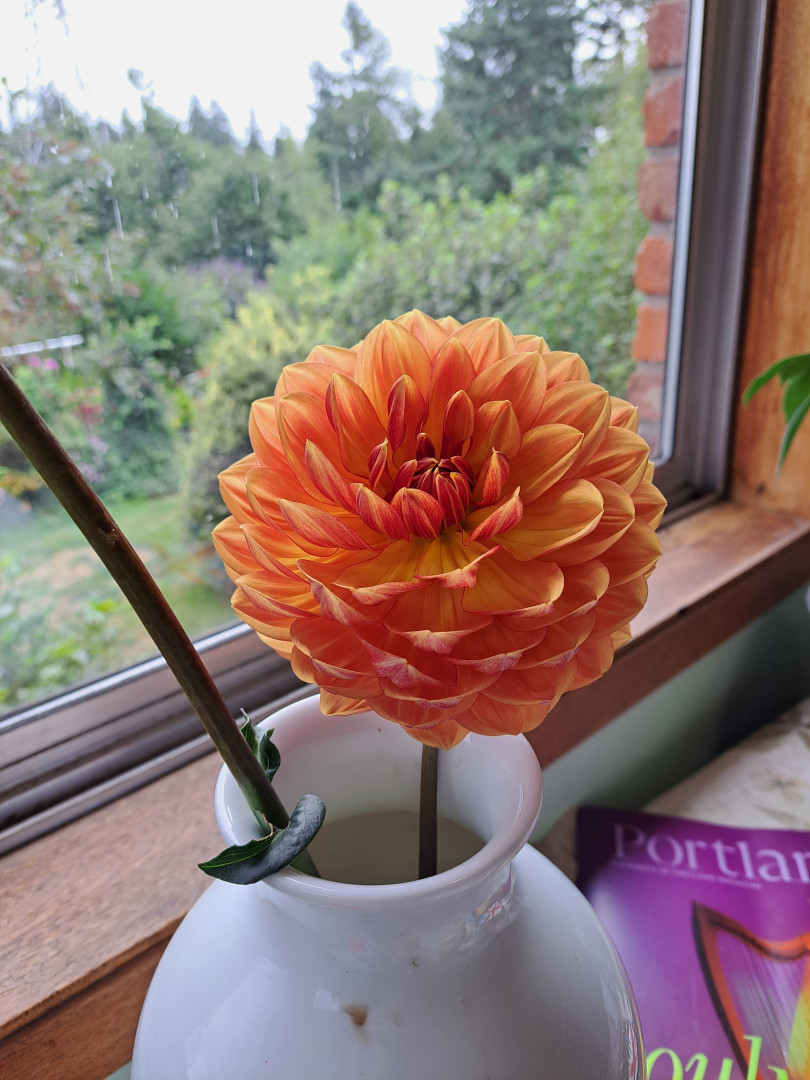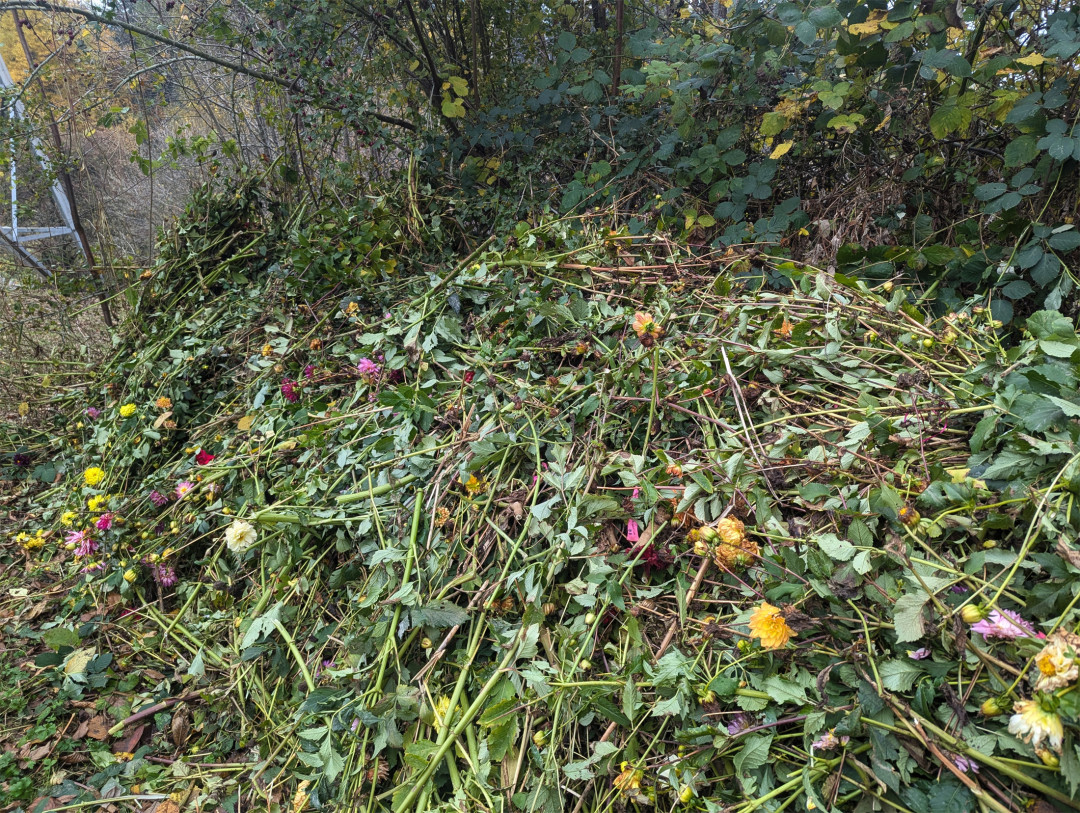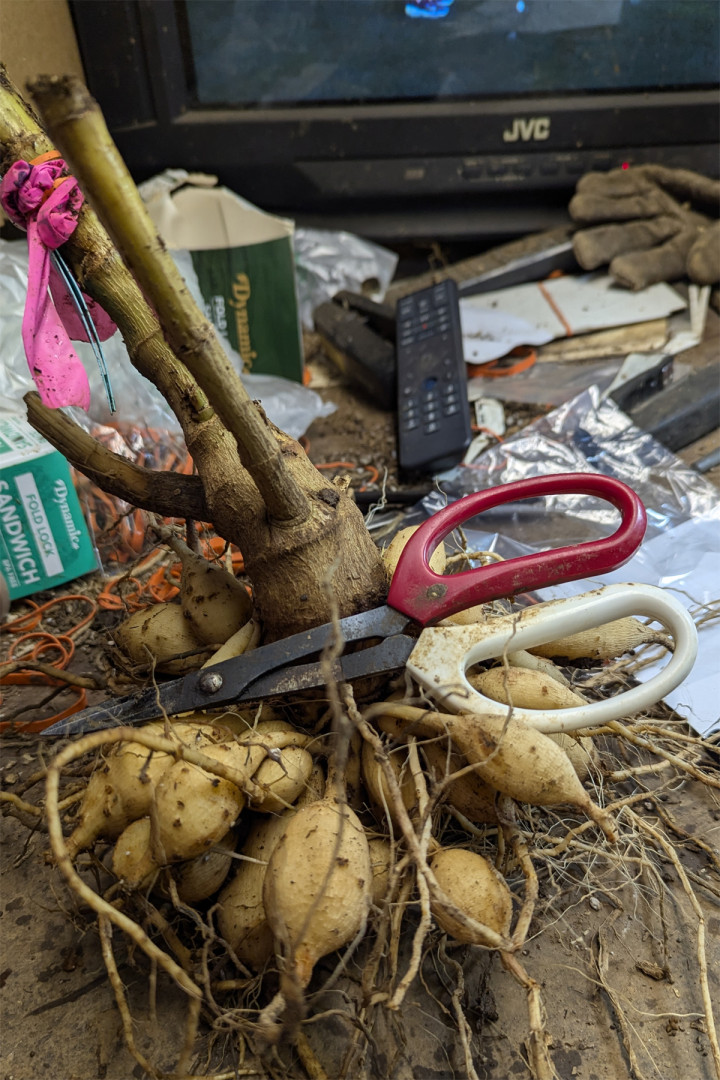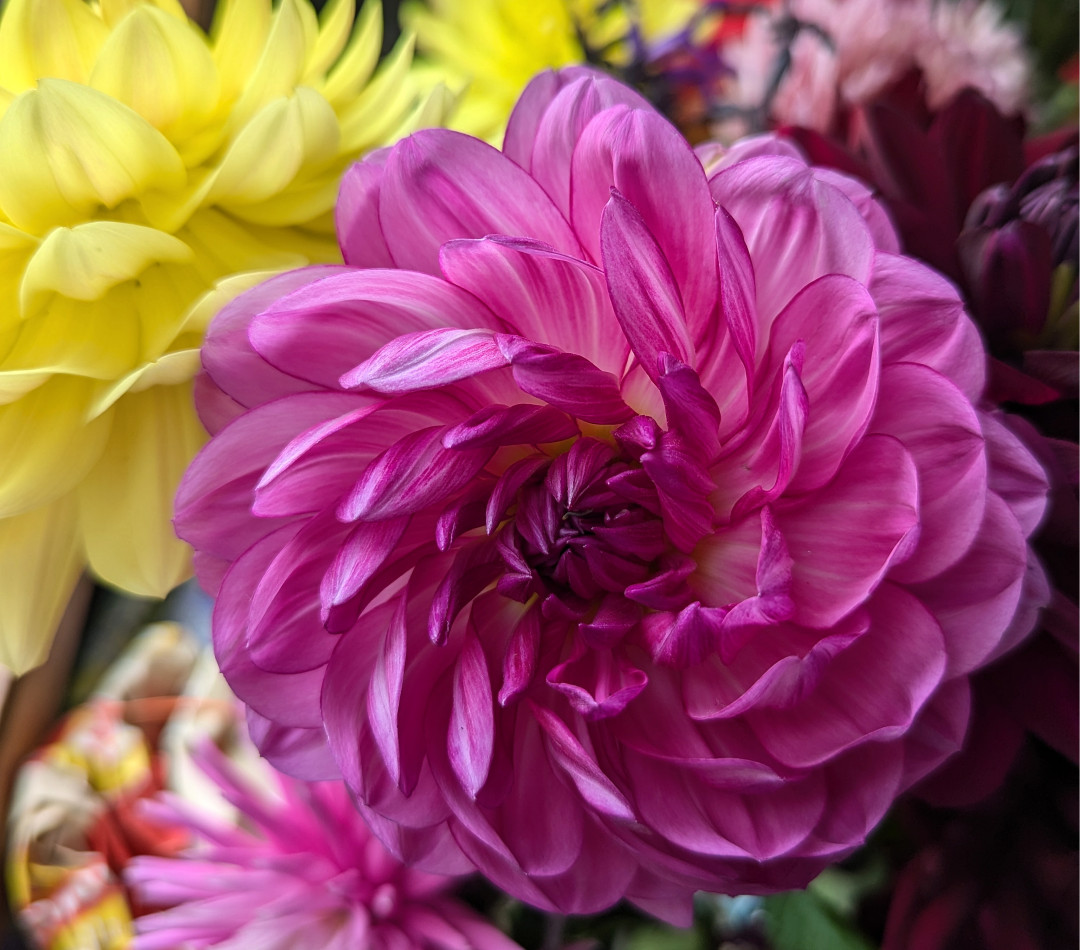There lots of dahlia tasks and some are physically difficult and others boring and repetitive. Two of the my favorites are evaluating the seedlings, especially the first year's crop and the other is gathering seed pods and shucking them. The physical requirements for evaluating seedlings sounds minimal but actually it involves going through a jungle of 6 foot tall seedlings and then crawling onto the ground to locate the plant tag indicating it's parent(s). Sounds easy-peasy but actually it does take some physical effort. Harvesting seed pods is very easy work. However, when the bag of pods reaches about 40 pounds carrying if from plant to plant is very strenuous. Oops, there may have been a typo there and 40 pounds should ahve been 40 ounces and perhaps gathering of seed pods is one of the very least strenuous dahlia activities.
And why am I listing strenuous dahlia tasks? Because physically digging tuber clumps is near the top of the most strenuous activities for an old geezer like me. Is pounding in T-posts with the heavy post slammer more strenuous?
Yes and no. There are only about 200 posts to slam and there are way more tuber clumps to dig, making it the most strenuous dahlia activity.
Dig Divide Repeat
Teddahlia my most hated job (and it’s also strenuous) is gathering up and disposing of all the foliage. So. Much. Foliage. And it’s all wet and gross and goopy.
I consider hauling the stalks away as part of the digging task. I have a big pile a few hundred feet away in our forest.
Teddahlia I have a big pile a few hundred feet away in our forest
I think that might be ok. I don’t have a forest (or a few hundred feet away) so mine have to be bagged and disposed of week after week in the garbage.
We love our forest but it really is only about 3 acres on a gentle slope and we have walking trail that is about 1,000 feet long to the bottom of the hill. We cheat and keep walking as the area below that is undeveloped too. An ice storm 3 years ago downed about 50 of our trees, mostly cherry trees but a few maples too. The mighty Douglas Fir trees were nearly undamaged by the ice. We have only cleared the walking trail of fallen trees and the remainder are horizontal and we have no plans to do much with them.
Teddahlia I am sure that nature has lots of plans of what to do with your horizontal trees...like nurse logs, and wildlife protectors, and mushroom nurseries...huckleberry patches, growing nettles....bird nests....It just gets real hard for us humans to get in and try to micromanage them.....
When I was at Swan Island Dahlias yesterday, tuber harvest was in full swing. One tractor was mowing the stalks and another tractor was pulling a device to lift the clumps out of the ground. It is an old fashioned potato harvester I think. There were several farm hands following that tractor and lifting the clumps into "home made" crates that are 2 x 8 boards made into a 4 foot square(I did not measure them and they may be a bit smaller) and old fashioned "chicken wire" nailed to the bottom. These are hauled to a storage building and stacked about 15 feet high and not washed. Dividing does not start for awhile and washing is done just before dividing. Meanwhile at the trial garden, instead of a tractor mower, I was using my trusty bonsai scissors to cut the stalks We were allowed to throw the stalks over the fence. Then instead of a tractor drawn potato harvester I used my 4 foot trenching shovel to lift the clumps from the ground. I like to harvest our entries there as the tubers are usually very nice. I placed the clumps into my collapsible vegetable crates. Our crew cleared the entire garden of stalks and clumps and threw all over the fence. The director did dig 6 clumps for entrants. 
Margaret's Picture of HH Golden Dawn in the kitchen.
I'm using a manure fork with round tines instead of my shovel for lifting this year. I have chopped fewer tubers for sure.
After lifting a few cuttings I can say for sure that KA's aren't the only varieties not producing tubers. A few others have had issues with Bull's Blood like I have, and of my two Sandia Bliss cutting plants only one grew tubers.
Trenching spade(not a shovel) is what I use. It has a long narrow blade that is started a long way from the clump so as to not to hit tubers and since it is angled way below the clump( and it is not a shovel), I can lever the clump up and out of the ground. The blade is much longer than any shovel or fork. For unimportant clumps I do not insert the blade on all 4 sides but for the important clumps I do so. And finally, I do most of my digging on my hands and knees. I like to be close to my work. If the ground is hard, I will do some work standing up but finish on my hands and knees.

Half way there.
- Edited
Teddahlia that’s a big foliage pile. Oof.
How many plants do you typically grow (in-ground - not pot tubers)?
- Edited
We plant about 3,000- but since we only keep about 10% of the first year seedlings and about 30% of the second and third year seedlings and we cull all bad stock, we probably only dig about 1500 and that may be a high number.
Teddahlia wow! I’m always so amazed at one- and two-man crews that manage so many plants! I grew about 450 this year and I’m intending to back down to 350 (last year’s number). No, for real this time. 
Yes, somehow my numbers rose by about 200...and my space did NOT increase. But I did start way more as seedlings this year then as tubers....with all the plants that have bloomed there are still many that did not. Now the bloomers have been dug and the weather is still mild....who knows what will happen to them...
My tubers are all put away except for the last of this years good Salish varieties to list and store most carefully..The Tuber Vault is full...Most tubers are small so there are many many tubers in there! I just have to pack the box of the ones that will go to Triple Wren to be grown out for possible sales, and then secure my supply of those varieties. And clean up my work space...I have many more tubers then usual but most of them are quite small...and we still had trouble with the beds being too wet. I told my "water management specialist" that next year we will keep check with more sophisticated tools so the tubers aren't so bumpy with lenticels. It is hard to write the names on some of them.
I left the seedlings that were too crowded to bloom this year in the garden beds and if they survive winter,which they most likely will, they should get a good head start for 2025.
I found only one plant with tuber gall and it was a small one deep in the heart of huge cluster of River's Coal Mine. Which of course was one of my favorites! The plant grew huge and healthy looking with beautiful blooms. It was hard to believe it when the gall showed up as I was dividing. I found NO leafy gall this year. I am going to use the bed that RCM was in for annual cutting flowers next year and switch the dahlias over to the long side bed where I have been growing annual cut flowers. It gets better sun and a longer day of sun exposure then the first dahlia bed (that went into shade mid afternoon.
Crown gall "tumors" are not always crown gall according to a Facebook post. He had his tested and it came back negative. The few times I have had it, the tubers would not sprout and so I learned early on to just toss any tuber with a tumor. My experience too was that an entire clump would not sprout so if I see a tumor on one tuber in a clump, the clump is gone. Now if it was the only one of that variety in the world I would probably break this rule and try to sprout the tubers in pots. Crown gall does not spread easily and does not seem to persist in the soil here. In the last couple of years I have not seen it here. And remember, we have never had a case of leafy gall, ever. I try to quarantine new stock and even then have never seen it but I am very careful about knowing the source of new stock.

First year clump. They take more time to divide and have never been this big. Netted about 8-9 tubers.
Teddahlia Very interesting! I did save some of the outside tubers on the big clump so I will isolate them and grow them to see what happens. What looked like Crown Gall to me was about 1" Tuber near the center of the big clump. I will also presprout the tubers I did save and keep them isolated and see if (1) they sprout, and (2) they appear trouble free...)
- Edited
Today I am sad because I accidentally grew some radishes. I planted them from dahlia tubers, and dahlia plants grew out of them, but they produced only tiny thumb-sized little tubers. 
The biggest disappointment to me was the Imera plant I grew from my Latvian purchase. It was gorgeous and full in the summer and upon digging, was revealed to be... Just the mother tuber and nothing else. A very fat and greedy mother tuber. I tried to dig away any rot on that lazy mother and stored her just the same. Just.... Sad.
Trick: If there is only a mother tuber and some very small pencil or even smaller tubers, leave those baby tubers attached to the mother tuber. These babies have good eyes and help the mother tuber grow well. The mother tuber provides nutrients to them. Without those small tubers the mother tuber may not even grow or grow very poorly.
I am banished to the garage dividing first year tuber clumps that are the biggest ever. If I did not have 30 years experience dividing clumps, these first year monsters would have been really difficult and although I know how to do it , the work is physical. 
Third year seedling. It always swirls like that .
